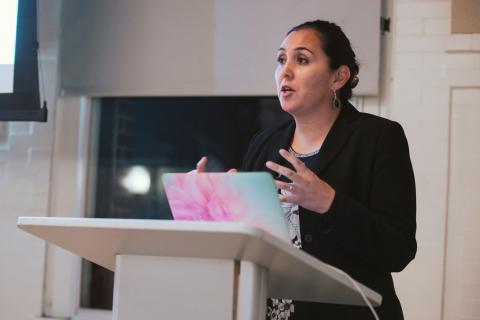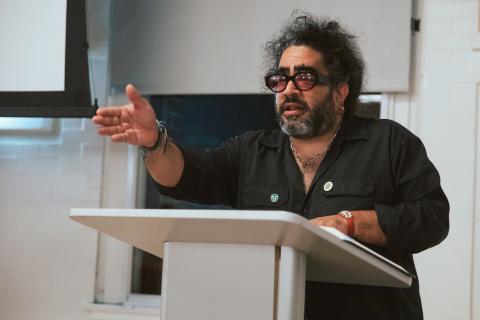Artistic Interventions in Latinx Cultures

Patricia Pérez, assistant professor in the Music Therapy Department
Image by Adam Ridhwan

José Falconi, lecturer in fine arts at Brandeis University
Image by Adam Ridhwan
What is the place of art in a world where tragedies happen everyday? According to the theory of aesthetics, art doesn’t technically have a function, which is what separates it from design. At a recent Berklee Center for Diversity, Equity, and Inclusion event, Patricia Pérez, assistant professor of music therapy, and José Falconi, lecturer in fine arts at Brandeis University, highlighted the purpose of art as a vehicle for protest, healing, and liberation.
Revolutions in Latin America to change geopolitical balances have been raging since 1910, while peace treaties are still being written to this day—social identities everywhere have been marked by colonization.
“So then,” Falconi posed, “What is the use of art in such a world?” After reciting poems by Latin poets such as Roque Dalton and Ernesto Cardenal, Falconi explained that a work of art has the ability to suspend one’s attention. “This is the first moment of an aesthetic experience. The second is when you connect with your reflection on the work of art.” He said, explaining that if art had a function, this would be it—it is the only instrument we can use to interrupt and intervene.
Pérez stepped up to present a beautiful composition, “my piece of intervention” she referred to it, as she narrated a personal story of grief regarding her aunt losing her husband to the revolution. “Flaco” is dedicated to her uncle Isidro Miguel Pizarro Meniconi, featuring beautifully haunting vocals, Pérez’s heart-wrenching saxophone melodies, and melancholic lyrics.
She underlined how much her aunt’s struggle went unnoticed and ignored, explaining the experience through a feminist theoretical perspective that argues that knowledge stems from social standing, and that the production of knowledge depends on the agenda of the privileged. Therefore the struggles of marginalized social groups such as the poor go unnoticed.
The song concluded with her saxophone entering deep dissonances, as Pérez clarified, “I wanted to ‘unlearn’ my playing, just as my aunt had to learn to ‘un-love’ her husband and live without him”—a powerful piece of artistic intervention.




